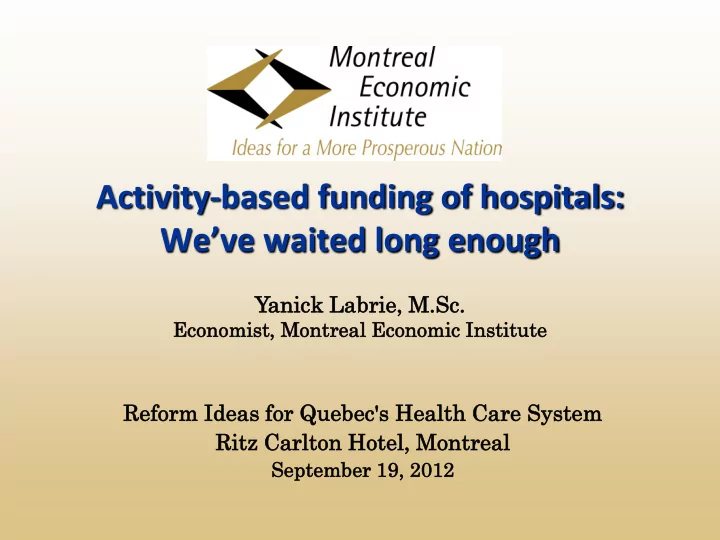

Activity-based funding of hospitals: We’ve waited long enough Yanick ck L Labri brie, , M.Sc. c. Econo Ec nomist, Mo Mont ntreal Ec Econo nomic I Inst nstitut ute Reform Id m Ideas fo for Que uebec's H Health C h Care Sys System Rit itz C z Carlt lton H Hot otel, el, M Mon ontreal September 19 19, 2012 12
Plan of the presentation Global budgets: at the root of the chronic problem of waiting lists in Quebec Activity-based funding: a model with better incentives The experiences of Scandinavia and England with ABF Some challenges
Global budgets: a funding model that needs to be re-examined Currently, nearly all Quebec hospitals receive their funding in the form of global budgets, based on amounts spent in the past Global funding offers no incentives for hospital managers to innovate in order to reduce expenses and improve access Patients are a source of additional expenses with this model, so there is no gain to make in trying to reduce wait times The chronic problem of waiting lists is thus rooted in part in hospitals’ global funding model
Accessibility and wait times Patients who must wait more than 5 days to see a doctor (%), 2010 70% 65% 60% 50% 40% 32% 30% 20% 16% 15% 15% 9% 10% 5% 2% 0% Source: Results from the International Surveys of the Commonwealth Fund, 2010
Accessibility and wait times Number of days before seeing a specialist, 2010 90 83 80 68 70 57 60 50 44 40 34 27 30 20 14 13 10 0 Source: Results from the International Surveys of the Commonwealth Fund, 2010
Accessibility and wait times Patients who must wait 4 months or more for elective surgery (%), 2010 30% 25% 25% 22% 21% 21% 20% 15% 10% 7% 7% 5% 5% 0% 0% Source: Results from the International surveys of the Commonwealth Fund, 2010
Making money follow hospital patients Most OECD countries adopted activity-based funding of hospitals during the last two decades These reforms gave hospitals better incentives: good performance is now rewarded with increased funding Reimbursement based on average cost (of treatment) put pressure on management to improve cost efficiency Reimbursement based on activity also contributed to improve access to care and reduce waiting lists ABF promotes competition and creates patient-centered care
Making money follow hospital patients The experience of Norway (1997): The reform entailed an increase in the annual growth rate of activity Public expenditures remained relatively stable or even decreased in real terms Resulted in a significant reduction in wait times From 2002 to 2006, hospital admissions jumped by 24% while average wait time for elective surgeries fell by 30%
Average waiting times (in days) for somatic treatment in Norway, 1998-2010
Making money follow hospital patients The experience of England (2003): Average length of stay fell rapidly after the implementation of the reform Better use of resources by hospitals led to more patients being treated with no reduction in quality of care The median wait time for elective surgery decreased by more than 60% between 2002-2010, partly because of ABF Reduction in wait times for cataract surgeries and hip and knee replacements has been greater for patients from less well-off areas
Evolution of waiting times for elective surgery in England, 1992-2010
Towards an activity-based funding reform Some challenges… Up-coding Cream skimming Discharging patient too early
Recommend
More recommend